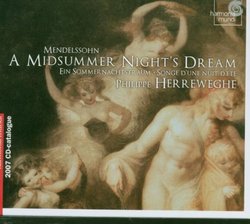| All Artists: Felix [1] Mendelssohn, Philippe Herreweghe, Orchestre des Champs-Élysées, Delphine Collot, Sandrine Piau Title: Mendelssohn: A Midsummer Night's Dream Members Wishing: 0 Total Copies: 1 Label: Harmonia Mundi Fr. Original Release Date: 1/1/2007 Re-Release Date: 3/20/2007 Album Type: Import Genre: Classical Style: Opera & Classical Vocal Number of Discs: 1 SwapaCD Credits: 1 UPC: 794881833023 |
Search - Felix [1] Mendelssohn, Philippe Herreweghe, Orchestre des Champs-Élysées :: Mendelssohn: A Midsummer Night's Dream
 | Felix [1] Mendelssohn, Philippe Herreweghe, Orchestre des Champs-Élysées Mendelssohn: A Midsummer Night's Dream Genre: Classical
![header=[] body=[This CD is available to be requested as disc only.]](/images/attributes/disc.png?v=15401716) ![header=[] body=[This CD is unavailable to be requested with the disc and back insert at this time.]](/images/attributes/greyed_disc_back.png?v=15401716) ![header=[] body=[This CD is available to be requested with the disc and front insert.]](/images/attributes/disc_front.png?v=15401716) ![header=[] body=[This CD is unavailable to be requested with the disc, front and back inserts at this time.]](/images/attributes/greyed_disc_front_back.png?v=15401716) |
Larger Image |
CD Details |
CD ReviewsMendelssohn as Puck's pupil Jacques COULARDEAU | OLLIERGUES France | 12/09/2007 (5 out of 5 stars) "This Midsummer Night's Dream is one of the Shakespearian plays that had a career of its own, along with Romeo and Juliet, in the musical field. Ballets, operas, and all other possibilities, plus of course numerous cinematographic adaptations. Here is the music Mendelssohn added to the play in the 19th century in the line of what Purcell did and is known as a semi-opera. The overture is a pretty brave piece that tries to musically recreate the atmosphere of the play split into many places, characters, plots and derangements. On the one side the court of Theseus. On the other beside the court of Titania, the Queen of Fairies. On the one hand the craftsmen and their play, on the other hand the marvelous, mischievous, adorable love object of all our phantasms, be we men as well as women, maybe not for the same reasons but love fascination all the same, that little juicy and both besotting and enamourable Puck. And I probably forget to oppose the city and the forest, the day and the night, and many other contrasting elements. Mendelssohn plays on the instruments in the orchestra, the tones of some of them, and of course the flavors he distributes here and there making us salivate at this deranged disorder and this harmonic chaos that are, both of them, so fascinating and mesmerizing. We fall into this Puckian trap at once. We are in the labyrinthine corridors of the surreal more than supernatural nightmarish dreamscape of that world famous and mythic play. And even a small piece of waltz can rock the cradle of our credulity. That is an overture and we are ready to enter the plot. Often will that spinning, whirling, tumbling, turning mode will come back in the smaller pieces without getting to a waltz. We are supposed to get light-headed, light-hearted and experience the vertigo of the fairy tale as we go down, drop and dive into the nocturnal world of pansies and lilies. And we will not be surprised by the Wedding March. It is grand, grandiose, brilliant. After all four couples get married or remarried at the same time, which makes eight people and that is the very number of the second coming of Jesus, the end of the world, paradise for all the worthy, eternal life for us all in the messianic Jerusalem, layer after layer of the gems that compose the walls of this dreamland city? And the funeral march is just as right, perfect, in tone and in harmony, and we recognize it at once as if we had lived in that other country all our life. The finale is sad, slow and the waltz of the overture comes back as if it were sad to be back to normal, to wake up in the ordinary world with hardly a full recollection of this other world that visited us. This particular recording directed by Herreweghe is a real marvel though I find his music slightly too clear, full of light, maybe even heavy and that takes away the fog, the mist and the magic of the play.
Dr Jacques COULARDEAU, University Paris Dauphine, University Paris 1 Pantheon Sorbonne & University Versailles Saint Quentin en Yvelines " |

 Track Listings (12) - Disc #1
Track Listings (12) - Disc #1